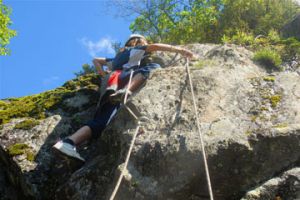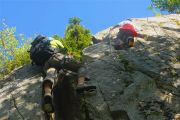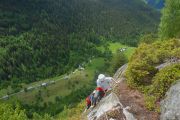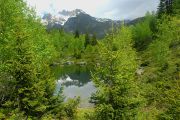 |

|
 Via Cordata Ste-Foy © T.Joly Via Cordata Ste-Foy © T.Joly

|
Half way between Via Ferrata and pure climbing, Via Cordata offers beginners the opportunity to learn climbing in complete safety while experiencing hair-raising sensations. One of the first to have opened in the Alps is located in Sainte-Foy-Tarentaise amidst gorgeous landscapes.
[ Practical ]
- Getting there
By road
690 km from Paris on autoroutes A6, A46, A42, A432, A43 and A430 till Albertville then N 90 and D 1090 till Sainte-Foy-Tarentaise.
By train
TGV from Paris Montparnasse to Chambéry then TER to Bourg Saint-Maurice. Duration of the journey : 5 to 6 hours
Night train from Paris Austerlitz to Bourg Saint-Maurice. Duration of the journey : 9 h 25.
Bus or taxi from Bourg-Saint-Maurice to Sainte-Foy-Tarentaise
- Lodging
Hotels :
Hôtel Le Monal
Auberge sur la Montagne
Auberge le Perce Neige
Bed and Breakfast :
La Ferme du Baptieu
Reservation center (Only for week stays)
Tel : 0479069522
- Restaurants
Le Monal
Le Perce Neige
Chez Merie
- Guides’ office
Tel : 0614629024
Price : 50 € per person. Groups of 4/5 persons maximum
- Information
Savoie Mont-Blanc Tourisme
Tel : 0144860460
www.savoie-mont-blanc.com
Tourist Office of Sainte-Foy-Tarentaise
Tel : 0479069519
www.saintefoy.net
Climb vertical walls, follow the crevices of a cliff to reach its summit.. Such high-adrenaline feats are no longer the reserve of confirmed sportsmen. Nowadays there are secure and fitted routes allowing beginners to cross passages which were forbidden to them in the past.
 100 % safe 100 % safe
The best known and oldest of these itineraries are the Via Ferrate, invented at the beginning of the 20th century and whose name means Iron Way. This is because these routes are equipped with a fixed metallic cable that runs all along their length as well as with iron rungs and ladders which facilitate passage through the toughest parts. Anchored to the metallic cable through two lanyards fixed to his harness, the climber runs no risk of falling. It’s 100 % safe. Moreover, the equipment attached to the rock allows climbers to traverse all obstacles, even vertical and smooth walls, whatever his or her skill level. The one condition is to be reasonably fit as this activity is physically demanding. Of course, it’s also better not to suffer from vertigo as it’s common to find yourself hanging in the emptiness, several hundred meters above ground. “But the Via Ferrate are sometimes good to cure people from this fear as they feel safe”, explain Jean-Paul Guidet, president of the Vanoise guides’ office.

 Via Cordata Ste-Foy © T.Joly Via Cordata Ste-Foy © T.Joly
|
 Roped up together Roped up together
However, these Via Ferrate do not please everybody. Some green activists and nature lovers complain that the metallic elements are not aesthetically pleasing and damage the sites. Moreover some climbers think that it makes for overly uniform routes where only the scenery changes. That’s why people have recently created the Via Cordata, or Via Corda, where the equipment on the walls is reduced to a minimum. First there is no metallic cable. Climbers must move roped up together through the karabiners of their harness. They follow a route punctuated with open pins and belays equipped with karabiners in order to anchor everyone together. “All is in position. There is no need to add anything. All anchorages are guaranteed and the safety is once again total”, says Jean-Paul Guidet.
But, while a Via Ferrata can be done between friends without much experience, especially on the easiest sections, a Via Cordata can only be done with a guide or with an experienced rock-climber who knows how to use a rope.

 Via Cordata Ste-Foy © T.Joly Via Cordata Ste-Foy © T.Joly
|
 Only with a guide Only with a guide
One of the most important rules is to keep the rope tight so that if one of the participants does fall the strain on the rope is less. For many some previous climbing experience is necessary. Especially as the metal fittings to help you progress are less numerous than in a Via Ferrata and smaller in size. As a result climbers are forced to make more use of the natural handholds offered by the rock, and to learn how to balance their bodies in order to reach them when there are a bit far away. “The Via Cordata requires more technique, is physically more demanding. Unlike the Via Ferrata, it allows you to make progress in rock-climbing techniques because there are greater similarities between the two activities. You must find the right path and choose your handholds… On a Via Ferrata you can compensate by relying more on strength”, underlines Jean-Paul Guidet. However Via Cordata are still difficult to find. There are only three in the Alps.

 Via Cordata Ste-Foy © T.Joly Via Cordata Ste-Foy © T.Joly
|
 Bursts of adrenaline Bursts of adrenaline
One of them is located in Sainte-Foy-Tarentaise, near Bourg-Saint-Maurice and Tignes. More exactly in the Crot valley, above the village, between 1 700 and 1 900 m of altitude. Inaugurated in July 2007, it is 600 m long and its difference in altitude is 190 m. This may look like a short distance but it takes two to three hours, sometimes even four, to complete. So it’s better to allow yourself half a day to do it since you need to add 10 mn walk to reach its base and 20 – 30 mn afterwards to go back to the parking area.
The basic route is classified 3/3+ with an optional route rated 4. Without the assistance offered by the Via Cordata this climb would be a 6+. It includes several slabs, short smooth walls, as well as spouts, ledges and horizontal crossings. On the optional way there is an additional spur. Everything you need for some good physical exercise and plenty of bursts of adrenaline. Particularly if you slip since underneath all is emptiness.
Fortunately there are a few narrow terraces where you can rest, quench your thirst, look at the flora and enjoy the breathtaking view of the surrounding mountains and over the valley.

 Sainte-Foy -Tarentaise© T.Joly Sainte-Foy -Tarentaise© T.Joly
|
 A reward for the climbers A reward for the climbers
This is also an opportunity for the guide to give advice for the following sections. And you’d be advised to pay close attention since putting your hands and feet in the right place makes all the difference. If not you get tired much quicker. A classic beginner’s mistake is to try and pull too much with the arms instead of first pushing with the legs. Easier said than done, and sometimes if you make the wrong choice you end up stuck on the rock-face. Then, the only option is to backtrack and try again. All of this is risk free, as all climbers are anchored together by a rope unrolled by the guide or the climber leading the group.
Once the Via Cordata is over, there is sometimes a reward for the weary climbers : the sight of chamois wandering in the Reserve du Bec Rouge which covers the area around the summit. While heading back down to the parking area, it’s also common to spot marmots and the scenery is gorgeous with, among other things, charming mountain lakes. A peaceful conclusion to a half-day of intensive sport.
April 20, 2012
Thierry Joly 

|



